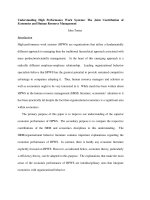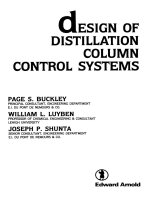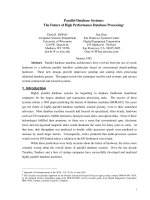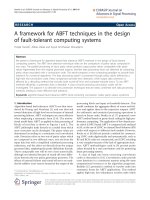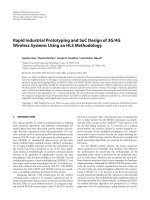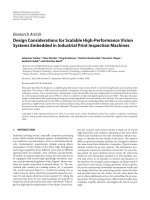Integrated servo mechanical design of high performance mechanical systems
Bạn đang xem bản rút gọn của tài liệu. Xem và tải ngay bản đầy đủ của tài liệu tại đây (1.95 MB, 142 trang )
Integrated Servo-Mechanical
Design of High-Performance
Mechanical Systems
Yan Zhi Tan
NATIONAL UNIVERSITY OF SINGAPORE
2014
Integrated Servo-Mechanical
Design of High-Performance
Mechanical Systems
Yan Zhi Tan
B.Eng. (Hons.), National University of Singapore, 2010
A DISSERTATION SUBMITTED
FOR THE DEGREE OF DOCTOR OF PHILOSOPHY
NUS GRADUATE SCHOOL FOR INTEGRATIVE SCIENCES AND
ENGINEERING
NATIONAL UNIVERSITY OF SINGAPORE
2014
Declaration
I hereby declare that this thesis is my original work and it has been
written by me in its entirety. I have duly acknowledged all the sources of
information which have been used in the thesis.
This thesis has also not been submitted for any degree in any university
previously.
Tan Yan Zhi
5 December 2014
i
Acknowledgements
To begin, I am indebted to my supervisors Prof. Lee Tong Heng, Prof. Pang
Chee Khiang, Justin, and Prof. Hong Fan. I am also grateful to Prof. Chen
Benmei for being the Chair of my Thesis Advisory Committee. They have
been great teachers who have taught me lessons both in life and research,
and they have opened up many opportunities for my career. I hold them
in high regards for their enthusiasm and passion in imparting knowledge
and conducting world-class research.
I wish to thank Prof. Ng Tsan Sheng, Adam of NUS Department of
Industrial and Systems Engineering for his invaluable comments and sug-
gestions on robust optimization. I am also grateful to Dr. Teo Tat Joo of
A*STAR Singapore Institute of Manufacturing Technology for the collab-
oration.
I would like to thank Prof. Won Sanchul of Pohang University of Science
and Technology for the research internship opportunity. I am also thankful
to Prof. Masayoshi Tomizuka of University of California, Berkeley, for the
research attachment opportunity. Both overseas research experiences have
been invaluable to me.
I am grateful to my parents Mr. Tan Boon Teong and Mdm. Seah Lee
Tiang for their upbringing, love and support. It has been an arduous jour-
ii
ney. I want to thank my best friends of twelve years and running, Mr. Lee
Guangyi, Mr. Toh Zong Rong, Ms. Choo Jiahui, Ms. Ong Hanwei, and
Ms. Seet Zhiyue, for the conversations, get-togethers, and adventures, etc.
In addition, I would like to thank all members of the research group for the
discussions and assistance. I am also thankful to NUS Graduate School
for Integrative Sciences and Engineering Scholars’ Alliance (NGSSA) for
adding more colors to my Ph.D. journey.
Last but not least, I would like to thank NGS for the financial support
in the form of a Research Scholarship. I would also like to thank the staffs
of NGS, as well as the staffs of Control & Simulation and Mechatronics
& Automation Laboratory, NUS Department of Electrical and Computer
Engineering, who have aided me in one way or another to make this dis-
sertation possible.
The thought of pursuing a Ph.D. had never crossed my mind when I
began my undergraduate studies with the department of Electrical and
Computer Engineering, NUS. This journey has pushed me out of my com-
fort zones, exploring uncharted territories, experiencing setbacks, and not
remembering how many times I nearly wanted to call it quits. However, it is
also this experience that has helped develop my tenacity and perseverance,
which I believe will serve me well for the journey ahead
iii
Abbreviations
CAD Computer-Aided Design
CVaR Conditional-Value-at-Risk
DBIT Discrete Bode’s Integral Theorem
EUV Extreme Ultra-Violet
FEA Finite Element Analysis
FIR Finite Impulse Response
GKYP Generalized Kalman-Yakubovich-Popov
HDD Hard Disk Drive
i.i.d. Independent and Identically Distributed
LMI Linear Matrix Inequality
LQE Linear Quadratic Estimator
LQR Linear Quadratic Regulator
LTI Linear Time-Invariant
MagLev Magnetic Levitation
iv
NRRO Non-Repeatable Run-Out
PZT Pb-Zr-Ti
R&D Research & Development
SISO Single-Input-Single-Output
Tbit Terabit
VCM Voice Coil Motor
ZOH Zero-Order Hold
v
Contents
Declaration i
Acknowledgements ii
Abbreviations iv
Table of Contents vi
Summary x
List of Tables xiii
List of Figures xiv
1 Introduction 1
1.1 Servo-Mechanical-PrototypeProductionCycle 1
1.2 PerformanceLimitationsofFeedbackControl 4
1.2.1 Limitations by Resonant Poles of Mechanical Plant . 5
1.2.2 Limitations by Unshifted Anti-Resonant Zeros of Me-
chanicalPlant 5
1.3 IntegratedServo-MechanicalDesign 7
1.4 Notations 9
vi
1.5 GKYPLemma 10
1.6 Phase-StableDesignandSensitivityDisc 12
1.7 PZT Active Suspension from Commercial Dual-Stage Hard
DiskDrives 14
1.8 MotivationofDissertation 17
1.9 ContributionsandOrganization 18
2 Integrated Servo-Mechanical Design of High-Performance
Mechatronics Using Generalized KYP Lemma 21
2.1 Background 22
2.2 YoulaParametrization 22
2.3 GKYP Lemma-Based Integrated Servo-Mechanical Design . 23
2.3.1 Performance and Positive Realness Specifications . . 26
2.3.2 DesignProcedure 27
2.4 SimulationExample 30
2.5 DiscussionofResults 34
2.6 Summary 41
3 Integrated Servo-Mechanical Design of Robust Mechatron-
ics Based on Ambiguous Chance Constraint 42
3.1 Background 43
3.2 Integrated Servo-Mechanical Design Based on Chance Con-
straints 44
3.2.1 PerformanceSpecifications 46
3.2.2 Chance-Constrained Robust Stability Criterion . . . 48
3.2.3 CVaR Approximation of Robust Stability Criterion . 52
3.3 DesignProcedure 55
vii
3.4 SimulationExample 58
3.4.1 PerformanceAnalysis 60
3.4.2 RobustnessAnalysis 61
3.5 ComparativeInvestigations 65
3.5.1 DeterministicAssessment 66
3.5.2 Probabilistic Assessment 67
3.6 Summary 69
4 Integrated Servo-Mechanical Design of Chance-Constrained
Robust Mechatronics Using Nyquist Plots 72
4.1 Background 73
4.2 Performance and Robust Stability Specifications 74
4.2.1 PerformanceSpecifications 75
4.2.2 Chance-Constrained Robust Stability Criterion . . . 75
4.3 MainResults 77
4.3.1 PerformanceSpecificationsonNyquistPlane 78
4.3.2 Chance-Constrained Robust Stability Criterion on
NyquistPlane 83
4.3.3 Relation between LMI and Graphical
Approaches 85
4.4 DesignProcedure 88
4.5 SimulationExample 91
4.6 PerformanceandRobustnessAnalysis 95
4.7 ComparativeInvestigations 98
4.8 Summary 103
5 Conclusion and Future Work 105
viii
Bibliography 110
List of Publications 122
ix
Summary
High-performance mechatronics are required to satisfy specifications such
as high control bandwidth, attenuation of disturbances at high frequencies,
and robust stability in the presence of plant parametric perturbations. In
the traditional cyclical research and development process for mechatronics,
the achieved feedback control performance may be limited by the mechani-
cal plant design. In this dissertation, novel integrated servo-mechanical de-
sign algorithms are proposed for reshaping the high-frequency response of
a single-input-single-output mechanical plant to satisfy performance spec-
ifications and individual chance-constrained robust stability criterion.
First, the reshaping of the high-frequency response of a plant based
on a low-order controller is proposed. The low-order controller is de-
signed to compensate for the frequency response of the original mechanical
plant at low frequencies, and plant design variables are introduced using
Youla parametrization. Performance specifications are specified as finite
frequency bounded realness constraints on the sensitivity transfer func-
tion, and the Generalized Kalman-Yakubovich-Popov (GKYP) Lemma is
used for translating the constraints into Linear Matrix Inequalities (LMIs).
Next, a convex separable parametrization is proposed for reshaping the
high-frequency responses of both the mechanical plant and a low-order
x
controller. The performance specifications are similarly represented as LMI
constraints using the GKYP Lemma, and an individual chance-constrained
robust stability criterion which is based solely on the mean, variance, and
support of the plant parameter distributions is included. A tractable ap-
proximation of the robust stability criterion under the conditional-value-
at-risk measure is proposed. As a result, the robust stability criterion is
formulated as several LMI and linear inequality constraints, where the LMI
constraints are obtained by translating positive realness constraints using
the GKYP Lemma. The design variables are solved simultaneously, and
the parameterization is readily separable for obtaining the redesigned me-
chanical plant and controller.
The performance specifications and chance-constrained robust stability
criterion can be visualized on the Nyquist plane, and a graphical approach
is proposed for redesigning the mechanical plant based on a low-order con-
troller to satisfy the specifications. Allowable regions for the Nyquist plot
of the open loop transfer function are derived based on the bounded-real
performance and positive-real robust stability specifications. The relation
between Bounded Real Lemma and Positive Real Lemma is used for con-
verting the positive realness constraint from the robust stability criterion
into an equivalent bounded realness constraint. In order for tradeoff be-
tween performance specifications and robust stability criterion to be eas-
ily observed using a single measure on the Nyquist plane, the equivalent
bounded realness constraint is approximated using Triangle Inequality.
This dissertation presents GKYP-Lemma based algorithms for satisfy-
ing performance and chance-constrained robust stability specifications by
finite frequency reshaping of the mechanical plant. The effectiveness of the
xi
proposed algorithms is verified in simulations using the Pb-Zr-Ti active
suspension from a commercial 3.5” dual-stage hard disk drive, which is an
example of high-performance mechatronics.
xii
List of Tables
1.1 θ
R
, ν,andκ forDifferentFrequencyRange 11
3.1 Assumptions on |
˜
δ
1
| and |
˜
δ
2
| 63
3.2 Assumptions on |
˜
δ
3
| and |
˜
δ
4
| 63
3.3 Summary of Closed-Loop Robust Stability Evaluation . . . . 64
3.4 Comparison of Closed-Loop Robust Stability 69
xiii
List of Figures
1.1 Typical servo-mechanical-prototype cycle for production of
mechatronicproducts[4] 3
1.2 Block diagram of a typical discrete-time feedback control
system 4
1.3 Frequency responses of mechanical plants with in-phase and
out-of-phaseresonantmodes. 6
1.4 Integratedservo-mechanical 8
1.5 Nyquist plot of open loop transfer function PC for phase-
stabledesign. 14
1.6 Internalstructureofadual-stageHDD 15
1.7 Measured and modeled frequency responses of PZT active
suspension. 16
2.1 Controller optimization using Youla parametrization. . . . . 23
2.2 Mechanical plant redesign using Youla parametrization. . . . 24
2.3 Detailed block diagram for the design of mechanical plant P
D
.25
2.4 Frequency responses of original plant model P , lag compen-
sator C, and open loop PC. 31
2.5 Frequency responses of sensitivity transfer functions. . . . . 35
xiv
2.6 Frequency responses of original plant model P , and designed
plants P
D
and P
MP
D
. 35
2.7 Frequency responses of complementary sensitivity transfer
functions. 36
2.8 Frequencyresponsesofopenlooptransferfunctions 38
2.9 Nyquistplotsofopenlooptransferfunctions. 39
2.10 Enlarged Nyquist plots of open loop transfer functions. . . . 39
2.11 Summary of additional steps for practical realization. . . . . 40
3.1 Block diagram for integrated servo-mechanical design. . . . . 45
3.2 Frequency responses of original plant P ,low-orderplantP
N
,
and redesigned plant P
D
61
3.3 Frequency responses of lag compensator C, redesigned con-
troller C
D
,andopenlooptransferfunctions. 62
3.4 Frequency response of sensitivity transfer function S. 62
3.5 Stability of synthesized feedback control systems under var-
iedplantparametricdistributions 65
3.6 Comparisonofopenlooptransferfunctions. 70
3.7 Comparisonofsensitivitytransferfunctions. 70
4.1 Relationship between ϕ and 80
4.2 Allowable regions (shaded) for Nyquist plot of P
D
C based
on performance and robust stability specifications. 82
4.3 Summaryofdesignalgorithm 91
4.4 Nyquist plot of P
D
C (thick solid lines) passing through al-
lowable regions from Constraint (a) and robust stability cri-
terion. 94
xv
4.5 Enlarged Nyquist plot of P
D
C (thick solid lines) passing
through allowable regions from Constraint (b) and robust
stability criterion. . 94
4.6 Frequency responses of original mechanical plant P and re-
designed plant P
D
. 95
4.7 Frequencyresponsesofopenlooptransferfunctions 97
4.8 Frequencyresponseofsensitivitytransferfunction. 97
4.9 Nyquist plots of open loop transfer functions satisfying Con-
straint (a). Solid: Sensitivity disc approach. Dotted: Pro-
posed. 100
4.10 Enlarged Nyquist plots of open loop transfer functions satis-
fying Constraint (b). Solid: Sensitivity disc approach. Dot-
ted:Proposed 100
4.11 Nyquist plot of P
D
C based on negative imaginary theorem. . 101
4.12 Frequency response of P
D
C and RBode constraints for ro-
bust stability. . . . 102
4.13 Frequency response of P
D
C and SBode constraints for per-
formance. 103
xvi
Chapter 1
Introduction
Mechatronics is usually defined as a synergistic combination of electronics,
mechanics, computer, and control [1]. Today, mechatronics is present in a
wide range of products ranging from consumer electronics such as desktop
printers, digital cameras, and Hard Disk Drives (HDDs), to industrial man-
ufacturing equipment such as industrial robots, wafer positioning stages,
and atomic force microscopes. Wafer positioning stages, atomic force mi-
croscopes, and servo systems in HDDs are examples of high-performance
mechatronics which are capable of nanoscale resolution.
1.1 Servo-Mechanical-Prototype
Production Cycle
The demand for smaller electronic devices, larger computational power,
and larger digital storage capabilities, etc, is ever increasing. Based on
the international technology roadmap for semiconductors [2], the manu-
facturing of integrated circuits will reach the few nanometers range within
1
the next fifteen years. As a result, the precision of semiconductor man-
ufacturing equipment such as wafer stages and atomic force microscopes
have to be increased. In addition, the precision of HDD servo systems
have to be increased further as areal densities of HDDs in production are
driven towards 10 Tbit/in
2
[3] in order to satisfy the storage demands by
data centers. As such, satisfying control specifications of high-performance
mechatronics is getting more challenging in many areas of application.
In a typical production cycle for mechatronic products as shown in
Figure 1.1, the business unit determines the requirements for the next gen-
eration of products based on consumers’ feedback, market forces, and tech-
nological innovations. The Research & Development (R&D) cycle for satis-
fying the requirements is an iterative process comprising of the mechanical
structure design, prototype manufacture and evaluation, and servo system
analysis stages, where each stage begins only after the completion of the
previous stages [4].
In the servo system analysis stage, the tracking accuracy of the high-
performance mechatronic system has to be ensured in the presence of me-
chanical vibrations, external vibrations, and measurement noise. Distur-
bance observers [5–7] and peak filters [8–10] are commonly augmented to
controllers for rejecting external vibrations. To reduce disturbances result-
ing from the mechanical vibrations, common methods include the phase-
stabilization of in-phase resonant modes [8, 11–13] and changing of the
mechanical properties of the out-of-phase plant to in-phase using peak fil-
ters [14].
The feedback control system is also required to be robustly stable in
the presence of plant parametric perturbations resulting from mass pro-
2
Figure 1.1: Typical servo-mechanical-prototype cycle for production of
mechatronic products [4].
duction, variations in operating conditions, mechanical wear, etc.Inthe
production of high quality and low cost mechatronic products such as the
HDD, the feedback control system is required to be stable for a given pro-
portion of the manufactured HDDs in order to satisfy a desired defect
tolerance level. Robust controller design methods are commonly based
on the H
∞
theory [15] considering norm-bounded uncertainties, as well as
Kharitonov’s theorem [16] considering interval polynomials. Controller de-
sign using probabilistic and randomized methods [17] are proposed recently
for improving the performance of feedback control systems, as the worst
case approach for considering uncertainties can be too conservative [17].
The dynamical performance of the overall control system is well known
to be dependent on both the controller and mechanical designs [18, 19].
3
As such, the achievable performance and robust stability of the feedback
control system may be limited by the mechanical plant.
1.2 Performance Limitations of Feedback
Control
The dynamics of many mechatronic systems can be modeled as a Linear
Time-Invariant (LTI) system when the operating range in consideration is
close to an equilibrium point. In this dissertation, the main performance
objective is achieving high-frequency disturbance attenuation for improving
tracking accuracy. As such, the performance limitations of feedback control
involving LTI systems are discussed in this section.
A typical discrete-time feedback control system is shown in Figure 1.2,
where C(z) is a feedback controller, u and y represent the input and output
of a mechanical plant P (z), respectively, r represents the reference signal
given to the overall control system, and w represents the output distur-
bance.
+
-
r
Controller C(z)
Plant P(z)
N
P
(z)
D
P
(z)
C
C
D (z)
N (z)
w
yy
w
+
+
u
Figure 1.2: Block diagram of a typical discrete-time feedback control sys-
tem.
4
1.2.1 Limitations by Resonant Poles of Mechanical
Plant
The closed-loop from w to y
w
as shown in Figure 1.2 corresponds to the
sensitivity transfer function S(z)whichisgivenby
S(z)=
D
P
(z)D
C
(z)
N
P
(z)N
C
(z)+D
P
(z)D
C
(z)
, (1.1)
where N
C
(z)andN
P
(z) are the zero polynomials of C(z)andP (z), respec-
tively, and D
C
(z)andD
P
(z) are the pole polynomials of C(z)andP (z),
respectively. Many performance specifications of the overall control system
can be characterized as magnitude constraints on S(z).
The resonant poles of P(z) are the zeros of S(z) as seen from (1.1).
When C(z) is a low-order controller and the resonant frequencies of P (z)
are fixed, disturbance attenuation capabilities at high frequencies can only
be achieved by decreasing the damping ratios of the poles of P (z)inD
P
(z).
1.2.2 Limitations by Unshifted Anti-Resonant Zeros
of Mechanical Plant
In mechanical design, the anti-resonant zeros of a mechanical plant indicate
the in-phase/out-of-phase property of the resonant modes. The frequency
response of a mechanical plant with in-phase resonant modes is shown in
Figure 1.3, where it can be seen that there are no unstable anti-resonant
zeros. From the frequency response of a mechanical plant with an out-
of-phase secondary resonant mode, it can be seen that there are unstable
zeros between the resonant modes. The anti-resonant zeros result in the
5
blocking of certain signal frequencies by the mechanical plant in control
design. As such, it is desirable to have only stable anti-resonant zeros in
the presence of mechanical resonant modes.
−40
−30
−20
−10
0
10
20
Magnitude (dB)
10
2
10
3
10
4
−450
−360
−270
−180
−90
0
Phase (deg)
Frequency (Hz)
With in−phase resonant modes
With an out−of−phase resonant mode
Figure 1.3: Frequency responses of mechanical plants with in-phase and
out-of-phase resonant modes.
The complementary sensitivity transfer function T (z) is a representa-
tion of the closed-loop from r to y in Figure 1.2, and is given by
T (z)=
N
P
(z)N
C
(z)
N
P
(z)N
C
(z)+D
P
(z)D
C
(z)
. (1.2)
From (1.2), it can be seen that the unstable anti-resonant zeros of P (z)are
the unstable anti-resonant zeros of T (z)whenN
C
(z)isSchurstable.
The locations of the unstable anti-resonant zeros are not shifted by feed-
back control and limit the achievable performance of the feedback control
system. In the presence of unstable anti-resonant zeros, an undershoot will
be seen at the beginning of the time responses with lengthened settling
6
time. In the frequency domain, the closed-loop bandwidth has to be low-
ered as the additional phase lag introduced by the unstable anti-resonant
zeros reduces the phase margin. According to the Discrete Bode’s Integral
Theorem (DBIT), the magnitude of S(z) is significantly greater than one
at frequencies above the open loop bandwidth [20].
1.3 Integrated Servo-Mechanical Design
Integrated mechatronic design is the simultaneous consideration of electron-
ics, mechanical, computer, and control components. According to [21], 43%
of more than 140 enterprises are implementing and altering new product
development processes for a multi-disciplinary approach to improving the
development of mechatronic products, with the top-performing manufac-
turers being twice as likely to do so. Integrated servo-mechanical design
is a subset of the more complex integrated mechatronic design problem as
shown in Figure 1.4. In other words, the focus is on considering mechanical
and control components simultaneously to satisfy performance specifica-
tions and robust stability criterion of the overall feedback control system,
and can be used for overcoming the limitations discussed in Sections 1.1
and 1.2.
From a theoretical perspective, integrated servo-mechanical design is
generally a nonlinear and nonconvex optimization problem. As discussed
in [22], the approaches can be classified into iterative [23–27], nested [28–
30], and simultaneous [31–36] optimization strategies. In [31], the sensi-
tivities of the objective functions with respect to the plant parameters are
used to formulate a gradient-based approach for simultaneous optimization.
7
